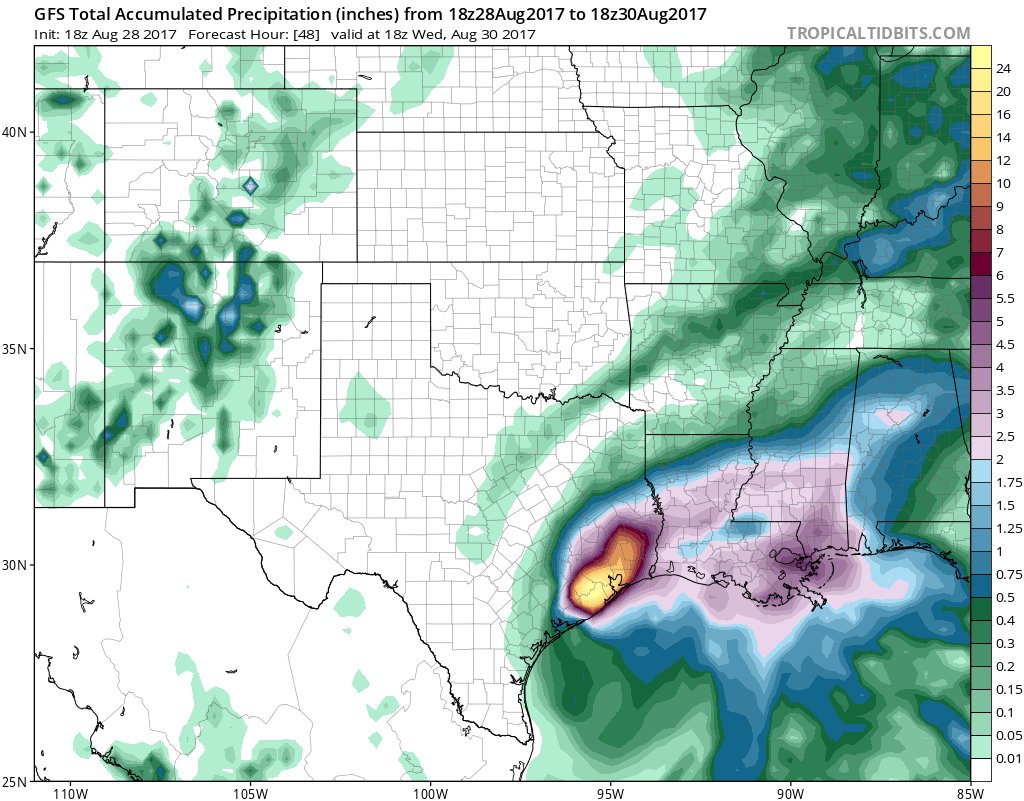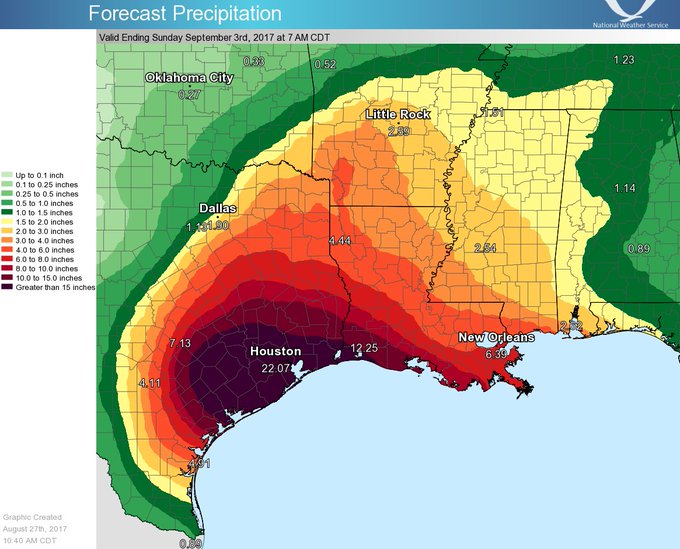Eric
Holthaus is one of the best and most honest reporters on climate
change in MSM.
This is scary. I have never seen a rainfall forecast like this in my entire career.
Texas will be recovering from #Harvey for years.
Harvey
is already the worst rainstorm in U.S. history, and it’s still
raining
By
Eric Holthaus

28 August, 2017
The
pictures are heartbreaking, the statistics are mind-boggling. And,
incredibly, it’s still getting worse.
Since
Hurricane Harvey made landfall in Texas late Friday night, more
than 40 inches of rain have
fallen in parts of the Houston metro area, producing the worst flood
in the city’s modern history. The latest
forecasts show
another 15-25 inches on the way before Harvey clears out of the area
on Wednesday. Harvey is sure to rank as the worst rainstorm in U.S.
history, according to an
initial analysis from
the Texas state climatologist.
“Of
course I’m surprised,” Houston meteorologist Tim Heller told
Grist. “We tell people to prepare for the worst, but this is worse
than the worst! This isn’t isolated flooding, this isn’t
neighborhood flooding, this is area flooding, regional flooding. The
warnings were there for 15-25 [inches] of rain, then 30, then 40. I
quit giving out storm totals because I’m not sure what we’ll end
up with now.”
The
amount of rain so far brings new meaning to the word “unprecedented.”
In just three days, Houston doubled the previous record rainfall for
a full month — 19.21 inches set in June 2001 during Tropical Storm
Allison (which caused the city’s previously worst flood).
So
much rain has fallen that the National Weather Service had
to add additional colors to
its maps, in order to show rainfall totals this huge. During the peak
of the rainfall on Saturday night, the local NWS office in
Houston ad-libbed
a dire warning and
issued a “Flash Flood Emergency for Life-Threatening Catastrophic
Flooding” — the first time the already-dire “Flash Flood
Emergency” was considered insufficient to describe the impending
risk.
This event is unprecedented & all impacts are unknown & beyond anything experienced. Follow orders from officials to ensure safety.#Harvey
All
weekend, there were impromptu water rescues made by people in kayaks
and inflatable rafts. A viral
image showed
a dozen people in a nursing home, water up to their hips, awaiting
rescue. (Eventually they were airlifted to safety.) These kinds of
scenes evoke painful memories of Hurricane Katrina in 2005, the
costliest natural disaster in U.S. history.
According
to a preliminary
and informal estimate by
disaster economist Kevin Simmons of Austin College, the aggregate
cost of damage and lost business associated with Hurricane Harvey
“will likely exceed Katrina.” That means Harvey could ultimately
cost between $150 billion and $200 billion, even more if the
floodwaters significantly expand.
Nearly
every river and stream in the Houston area is experiencing record or
near-record flooding. Buffalo Bayou, the main waterway through
downtown Houston, is expected to rise an
additional 11 feet by
Tuesday night. Texas Governor Greg Abbott has mobilized the
entire Texas National Guard to
assist with the response.
While
Harvey’s rains appear unique in U.S. history, heavy rainstorms are
increasing in frequency and intensity worldwide — a clear
sign of climate change.
A warmer atmosphere can speed evaporation rates and hold more
moisture, and Harvey’s flood comes via a firehose of intense
thunderstorms spawned off a warmer-than-usual Gulf of Mexico.
The increasing
intensity of rainfall in
the Houston area is only part of this problem, though: Unchecked
development has added dozens of square miles of pavement to the
swamps and prairies surrounding the city, channeling additional
floodwater into homes. That means Harvey is a storm decades in the
making.
But
Harvey’s wrath is on a whole new level. This is the scale of
disaster that will redefine the course of the entire region, and
linger in the country’s consciousness for years. It will provide an
opportunity to rethink Houston, the fourth-largest city in America.
And, hopefully, mark the first step on a path toward a more resilient
future.
To emphasize as strongly as possible, this isn't over yet. Another 15-25" (in and of itself a catastrophe) still on the way for Houston.







No comments:
Post a Comment
Note: only a member of this blog may post a comment.